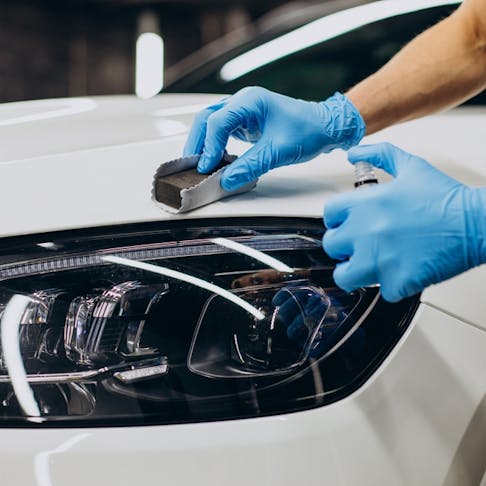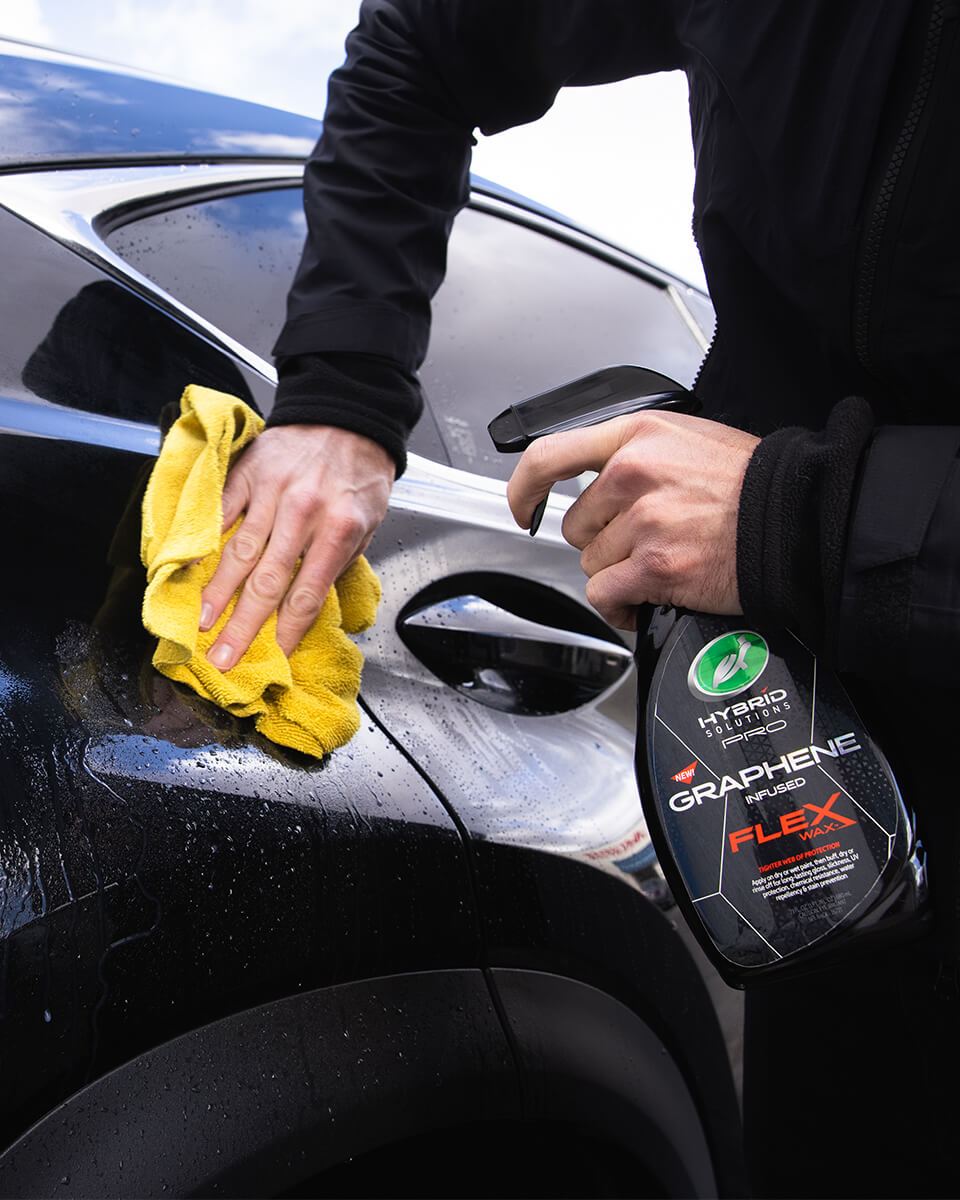Exploring the Science Behind Car Ceramic Coating and Its Protective Properties
The science of car ceramic coating provides a remarkable research in advanced automobile security. Made up largely of silicon dioxide and polymers, these coatings form a robust bond with automobile paint. This communication enhances durability versus environmental threats while using hydrophobic benefits. The ins and outs of just how these finishings work and their long-term advantages remain less understood. Ceramic Coating Newark. Unpacking these information discloses why ceramic coatings are coming to be a recommended selection for automobile care
What Is Ceramic Coating?
Ceramic coating is a liquid polymer that chemically bonds to the surface of an automobile's paint. This advanced safety layer improves sturdiness and supplies premium resistance to environmental elements. Unlike standard wax or sealers, which supply momentary protection, ceramic finishes develop a durable guard that can endure rough conditions such as UV rays, acidic contaminants, and severe climate. When applied correctly, the coating forms a hydrophobic surface, causing water to grain and slide off, which aids in maintaining the lorry's tidiness. Furthermore, it offers boosted gloss and depth to the paint, making the lorry appear more refined and dynamic. The application procedure typically includes extensive surface area prep work, consisting of cleansing and sprucing up, to guarantee peak bonding. Therefore, ceramic finishings are ending up being increasingly preferred among car enthusiasts and those seeking to protect their investments, assuring to maintain the vehicle's aesthetic allure while reducing the regularity of upkeep.
The Structure of Ceramic Coatings
The detailed formula of ceramic coatings mainly contains silicon dioxide (SiO2), which is originated from all-natural sources like quartz and sand. This crucial component offers the structure for the coating's resilience and protective qualities. In enhancement to SiO2, ceramic coatings often consist of numerous polymers and additives that improve bond, adaptability, and resistance to environmental variables. These substances function synergistically to develop a robust barrier versus contaminants such as dirt, chemicals, and UV rays.Furthermore, some formulas integrate titanium dioxide (TiO2) or other nanomaterials, which can enhance the coating's hydrophobic properties, resulting in enhanced water repellency. The precise composition can vary greatly among makers, influencing efficiency and long life. Inevitably, the mix of these elements finishes in a protective layer that not only enhances the visual charm of lorries however likewise serves to prolong their lifespan by protecting the surface area from prospective damage.
How Ceramic Coatings Work
Recognizing how ceramic layers function includes exploring their chemical composition, which contributes to their protective top qualities. The application process is necessary for accomplishing suitable outcomes, while durability and resilience aspects figure out the coating's efficiency in time. Together, these elements highlight the advantages and efficiency of ceramic coverings for vehicle defense.
Chemical Structure Explained
While lots of car proprietors seek long-lasting defense for their vehicles, the chemical structure of ceramic layers plays a vital role in their effectiveness. These coverings primarily are composed of silicon dioxide (SiO2), which is stemmed from natural minerals. This substance forms a solid bond with the car's paint, developing a long lasting, protective layer. Furthermore, lots of ceramic coverings consist of titanium dioxide (TiO2), improving their hydrophobic residential or commercial properties and resistance to UV rays. The existence of polysiloxanes can additionally improve versatility and resilience. Together, these aspects contribute to the coating's capability to drive away water, dust, and impurities, while also giving a high-gloss surface. Understanding this chemical structure helps car owners value the robust defense used by ceramic coverings.
Application Process Overview
Applying ceramic layers involves a careful procedure that guarantees excellent bonding and security for the car's surface area. Originally, detailed cleaning and purification of the car's exterior are performed to get rid of dirt, gunk, and previous waxes. This action validates that the surface area is free from pollutants that might visit our website hinder bond. Following this, the paint is often polished to enhance clarity and remove any kind of blemishes. As soon as prepared, the ceramic coating is applied in small sections using an applicator pad, permitting consistent protection. The coating is after that entrusted to heal, creating a solid chemical bond with the surface area. Appropriate healing times and problems are important, as they verify the coating attains its maximum performance and protective qualities.
Long Life and Resilience Elements
Ceramic coverings are designed to provide lasting defense with their advanced chemical structure, which creates a durable obstacle versus environmental contaminants. The durability of these finishes is influenced by variables such as the density of the application, the top quality of the item, and the conditions under which the car is exposed. High-quality ceramic finishes can last a number of years, resisting scrapes, UV rays, and chemical discolorations. Proper upkeep, including routine cleaning and routine reapplication, can even more improve longevity. In addition, environmental factors like environment and exposure to toxins can impact the life-span of the coating. In general, when used and kept appropriately, ceramic coverings provide exceptional longevity, making them a popular choice for car enthusiasts looking for to preserve their car's appearance.
Hydrophobic Properties and Water Repellency
Hydrophobic residential properties are a hallmark of quality car ceramic coatings, considerably enhancing the vehicle's surface area efficiency. These coverings produce a molecular bond with the car's paint, resulting in a surface area that drives away water properly. When water enters contact with a ceramic-coated surface area, it beads up and rolls off, lessening the amount of liquid that remains on the paint. This actions not just adds to a cosmetically pleasing look but additionally reduces the build-up of impurities such as dirt, gunk, and road salts.The improved water repellency causes simpler cleansing and upkeep, as less effort is needed to eliminate unwanted substances. Additionally, the hydrophobic nature of ceramic finishings aids in stopping water spots, which can mar the surface of uncoated surfaces. On the whole, the unification of hydrophobic residential properties in ceramic coatings plays a crucial role in preserving the automobile's beautiful look while streamlining maintenance.
Defense Against Scratches and UV Damage
Car ceramic layers offer considerable security look at this website versus scrapes and UV damage. The scrape resistance mechanism creates a sturdy layer that absorbs influences, while the UV protecting benefits assist maintain the vehicle's paint stability over time. Together, these attributes add to a longer-lasting and visually enticing finish.
Scrape Resistance Device
Making use of sophisticated modern technology, ceramic finishings provide a durable guard against scratches and UV damage, improving the durability and look of vehicle surface areas. The scrape resistance mechanism of these finishes is attributed to their distinct molecular framework, which creates a sturdy bond with the vehicle's paint. This bond develops a hard, safety layer that can take in impacts and stand up to abrasions. Additionally, the smooth surface of the coating lowers rubbing, making it challenging for contaminants to stick and create scrapes. The chemical composition of ceramic layers typically includes nanoparticles that enhance the safety layer, more improving its durability. Automobiles treated with ceramic coatings exhibit considerably enhanced scrape resistance compared to standard wax or sealants, making certain a pristine coating over time.
UV Shielding Advantages
The safety top qualities of ceramic finishes prolong beyond scrape resistance to consist of significant UV protecting benefits. These coatings develop a robust barrier that reflects unsafe ultraviolet rays, guarding the automobile's paint and underlying products. Long term exposure to UV radiation can lead to fading, oxidation, and wear and tear of the paint coating. By incorporating ceramic coverings, lorry owners can effectively alleviate these risks, maintaining the visual appeal and honesty of their automobiles. In addition, the UV obstructing buildings add to boosted long life, decreasing the frequency of repainting and maintenance. Inevitably, the combination of ceramic finishes offers a detailed option for safeguarding cars from the destructive effects of sun direct exposure, guaranteeing a sustained, lively look with time.
The Durability and Maintenance of Ceramic Coatings

Frequently Asked Questions
Can Ceramic Coating Be Applied to Any Kind Of Sort Of Lorry?
Ceramic coating can be put on various kinds of lorries, consisting of autos, vehicles, and motorbikes. Nonetheless, surface area prep work and compatibility with details products are vital for suitable attachment and performance of the coating.
How Much Does Ceramic Coating Usually Price?
Ceramic coating usually costs between $500 and $2,000, depending on aspects such as automobile size, coating high quality, and professional application. The investment can supply resilient protection and improve the automobile's look gradually.

Is Expert Application Required for Best Results?
The need of professional application typically depends upon desired results. Experts usually ensure proper surface prep work and application techniques, leading to optimal bonding and long life of the coating, which might be testing for inexperienced people to attain.
Can Ceramic Coatings Be Eliminated or Fixed?
Ceramic finishings can be eliminated or fixed, though the process may call for specific solvents or strategies - Ceramic Coating Newark. Proper elimination is necessary to avoid damage to the underlying surface, highlighting the importance of expert aid for suitable outcomes
Exactly How Does Porcelain Coating Contrast to Standard Wax?
The comparison in between ceramic coating and traditional wax discloses that ceramic finishings offer remarkable toughness, enhanced security versus environmental impurities, and longer-lasting luster, while wax calls like this for extra frequent application and gives less general resistance to damages.